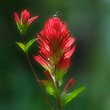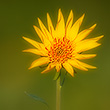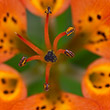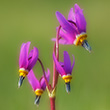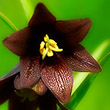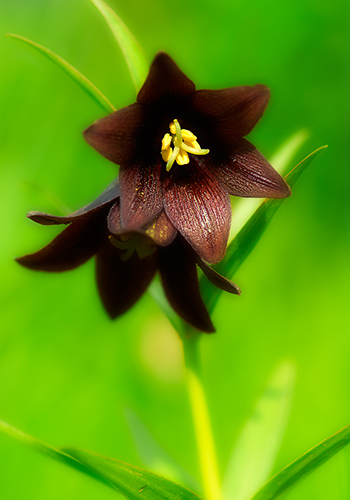
Availability: Limited Edition Print; RM Stock (??)
In the Field
Kamchatka Fritillary in Sunshine. Khutzeymateen Inlet, BC, Canada. June 5, 2006.
Kamchatka Fritillary (also known as Rice Root and Black Lily) is found in moist habitats from tidal flats to mountain meadows along the northwest coast of North America (from northern Washington State in the south up through the BC coast and as far north as Kodiak Island). The bulbs of this fritillary resemble white rice and were eaten by virtually all the indigenous people of the northwest coast.
This is an example of a "grab-it-quick-and-pray" image. I normally like to take my time when I'm shooting flowers or doing any macro work, but I found this Kamchatka Fritillary (A.K.A. Black Lily) in the Khutzeymateen Inlet during grizzly bear breeding season. And, there were LOTS of grizzlies around. So...for obvious reasons, I chose to grab this image as quickly as possible - I shot it hand-held (which I almost NEVER do with macro work) and without a cable release. But...I got lucky and managed to capture an acceptable image!
Alert - Digitally Manipulated Image: This image clearly crosses the line from simple digital correction to digital manipulation. The soft, dream-like image you are viewing is partially the product of digital manipulation. For details on how this image was produced, see Bio: Techniques (I refer to this technique as the "Wildflower Effect").
It is my policy to clearly identify ANY images on this website that overstep the bounds of digital correction and enter the territory of digital manipulation (see Voice: Commentary: Digital Correction vs. Digital Manipulation).
Behind the Camera
Kamchatka Fritillary in Sunshine. Khutzeymateen Inlet, BC, Canada. June 5, 2006.
Digital Capture; Compressed RAW (NEF) format; ISO 200.
Nikon D2X with Nikon AF-S Micro 105 mm f/2.8 ED-IF N VR lens (157 mm equivalent with digital conversion factor) - handheld.
1/350s @ f5; no compensation from matrix-metered exposure setting.
At the Computer
Kamchatka Fritillary in Sunshine. Khutzeymateen Inlet, BC, Canada. June 5, 2006.
RAW Conversion to 16-bit TIFF, including first-pass sharpening, exposure compensation, and tone curve adjustment using Phase One's C1 Pro.
All further digital correction on 16-bit TIFF file using Adobe's Photoshop CS2, including selective Gaussian blur, compositing and blending of blurred and sharp layers, selective saturation enhancement, and selective sharpening for web output.
Conservation
Kamchatka Fritillary in Sunshine. Khutzeymateen Inlet, BC, Canada. June 5, 2006.
Ten percent of the revenue generated by this image will be donated to Raincoast.
Species Status in Canada*: While this species is not designated as at risk, it is considered "sensitive to disturbance" by many authors.
Kamchatka Fritillary (Fritillaira camschatcensis) is most commonly found in coastal areas but is occasionally found inland as well. Historically the bulbs of this species were eaten by virtually all the indigenous people of the northwest coast of North America. The species is not considered invasive and in not known to be poisonous.
This Fritillary was photographed in the Great Bear Rainforest of British Columbia and while the species itself is not considered at risk, the habitat in which it was found is under threat. The Raincoast Conservation Society (and Foundation) is fighting to protect the Great Bear Rainforest along the central and northern coast of British Columbia. This unique ecosystem harbours a strong population of many high-profile species such as Brown Bears and Gray wolves, plus habitat that is important to the Kamchatka Fritillary. If you are looking for a meaningful way to contribute to the conservation of this amazing ecosystem, Raincoast will provide maximal "bang" for your conservation dollars.
*as determined by COSEWIC: The Committee on the Status of Endangered Wildlife in Canada


















